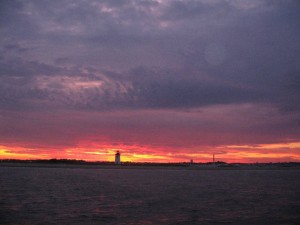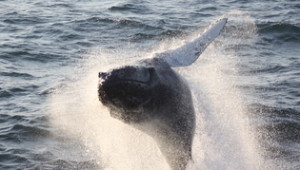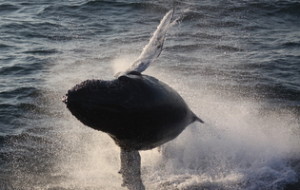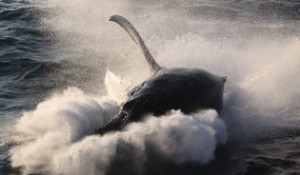Dolphin Fleet Naturalist Notebook – 3 July to 9 July
On July 3rd we left Provincetown Harbor and headed northeast until we arrived in the “Triangle”, an area in the southeastern corner of the Stellwagen Bank National Marine Sanctuary. We soon encountered our core group of humpbacks, iincluding Cajun and her calf, Milkweed, Pele, and Alphorn. For the past few weeks, Cajun and her calf have been accompanied by a rotating entourage of other humpbacks, both male and female, occasionally gathering a group of 8 to 9 animals! The adult humpbacks disappeared for dives lasting 8 to 10 minutes, but Cajun’s calf stayed at the surface, occasionally fluking and rolling. While we waited for the adults to return to the surface, we noticed that a small group of Atlantic white-sided dolphins had moved into the area. Stellwagen Bank is a highly productive marine ecosystem, and many animals will visit the area throughout the year because it tends to be an excellent place to find food. It is likely that whatever the humpbacks were feeding on below the surface had also attracted the attention of the dolphins!
On July 4 Dolphin Fleet vessels spent the day whale watching and the evening back in Provincetown Harbor for fireworks and sunset viewings. While town filled up with vacationers from all over the northeast, Stellwagen Bank provided a peaceful refuge for those of us wanting to avoid the hustle and bustle of town. Two new humpback mom/calf pairs included Ravine and her calf, as well as Circuit and her calf. As of the first week in July, at least 40 new mom calf pairs have been seen in the nutrient-rich waters of the Gulf of Maine. It sometimes takes mothers and their young a little bit longer than the rest of the population to leave the breeding grounds in the Caribbean and West Indies, so it is not unusual to get our first peeks this late in the season. Once they get here, moms have to work hard to find food. During the process of giving birth and nursing, they may have lost up to 1/3 of their body weights!
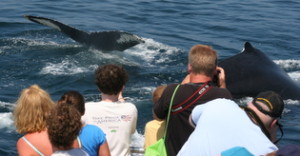
On July 6th, a number of humpbacks were documented during the evening trip, and the naturalists suspected that there was quite a bit of subsurface feeding going on. Naturalists and passengers alike observed large clouds of bubbles rising to the surface. This is indicative of humpback feeding behavior because humpbacks use these clouds of bubbles to corral and confuse sand lance before lunging through the school of fish. Humpbacks have a more generalized diet than many other species of baleen whales and can feed on many different species of small schooling fish, as well as the occasional krill patch. Humpbacks seem to be able to alter their feeding behavior depending on the prey they are after. When they go after herring, for example, they can be very noisy, using clicks and whistles to confuse their prey. For sand lance, however, bubbles seem to be the way to go!
Because we don’t rely on advanced technology like radar or sonar to find whales, our first trip of the day can sometimes be an exercise in patience as we track down the humpbacks that may have moved to different locations overnight. Luckily, our crew consists of expert whale spotters who can locate a spout from miles away using only binoculars and the naked eye! On July 7th, we were able to locate our first group of humpbacks approximately an hour from the dock. We initially spotted a group of five humpbacks consisting of Perseid, Firefly and their respective calves, as well as a large male named Alphorn.
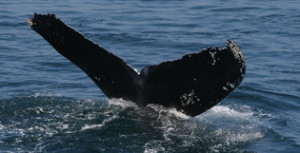
As it came time to head back to shore, we lingered for another minute to watch a harbor seal which had lifted its head out of the water in a behavior called “bottle-nosing”. We recognized this as a harbor seal because of its smaller size and dog-like face. Harbor seals are approximately 5 feet long as adults, much smaller than gray seals, which also inhabit the waters off of Cape Cod. Gray seals can be distinguished by their larger size (up to 8 feet) and horse head-like profile.

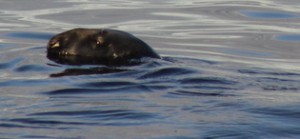
In the photos above, see if you can distinguish between the profiles of these two pinnipeds or “fin-footed” marine mammals. And for more information on current seal research on Cape Cod, see the Provincetown Center for Coastal Studies’ website.
Meanwhile, on the Dolphin VI, there was high drama at sea when an explosion on a small pleasure craft near the whale watch boat prompted a rescue effort from the crew of the Dolphin VI. Thankfully, no one was hurt, and we were very proud of our crew for their prompt and professional response. Go here to read the full story.
July 8th was a truly remarkable in that throughout the day, four different species of large whale were seen breaching! It is not known exactly why whales breach, but it tends to happen more frequently as the wind picks up. Today, relief from the stagnant heat was broken by a moderate breeze, and the whales seemed to notice as well. Humpback whales are, of all of the large whales seen in the area, the most likely to breach. In the afternoon, an unidentified humpback was observed breaching repeatedly.
As the breeze continued throughout the afternoon, more and more species seemed to be riled up by the change in the weather. The normally elusive Minke whale also made an appearance and leaped straight out of the water, flippers at its side, only to belly-flop down and start all over again. Even though there are many Minke whales in the area, their speed and elusive behavior makes them hard to see. When they breach, we finally can get a good look at the entire animal.
On one of the afternoon trips, our naturalist peered into the distance following a huge splash several miles away. It didn’t look like the typical profile of a humpback, but instead looked long and lean, like a fin whale. As we continued to look, we concluded that it was either a fin whale or a sei whale. Fin whales are the second largest animal on the planet and are rarely seen breaching. Sei whales resemble the fin whales, but are not quite as large, and lack the distinct, bright white pigmentation on the right jaw.
The true finale of the day was on the 5:30 trip when we saw a breaching mother and calf North Atlantic right whale. It is always a surprise to see a right whale at this time of year because most of our right whales congregate in Cape Cod Bay in March and April, only to head off to the Great South Channel, east of Nantucket for the early part of the summer. As they migrate northward to the Bay of Fundy for the later part of the summer, some of them will tend to stop by their winter feeding ground, so it is not entirely unheard of to catch sight of a few passing through on their journey northward. Truly, any sighting of a right whale is a treat as there are only about 400 of them left on the entire planet! It is against federal law to approach a right whale within 500 yards, so we were not close enough to get pictures, but we were able to identify the species by their bulbous black bodies lacking a dorsal fin.
July 9th was another gorgeous day and we couldn’t wait to leave the dock to escape the blazing heat on land. The afternoon trip aboard the Portuguese Princess II began with a breaching display by Cajun’s calf. Cajun’s calf has been one of our favorites during this season because of her energy and acrobatics. She frequently will breach and flipper slap while her mother is down on deep dives. Maybe she is trying to get her mom’s attention!
We left Cajun and her calf and moved over to Apostrophe and her calf, who were joined by another humpback named Charger. Apostrophe and her calf soon left the area, leaving us with a very curious Charger. Charger swam back and forth under the boat, alerting us to his presence with a thin stream of bubbles that would burst at the surface about 30 seconds before Charger would emerge. Passengers rushed back and forth between the port and starboard side of the boat, trying to guess where Charger would pop up next. Finally, in a final burst of curiosity, Charger emerged from the water in a half spyhop, half breach, perhaps in an attempt to get a better look at our boat. Eventually, we had to leave Charger behind and head back to shore, wrapping up a beautiful week out on Stellwagen Bank.







